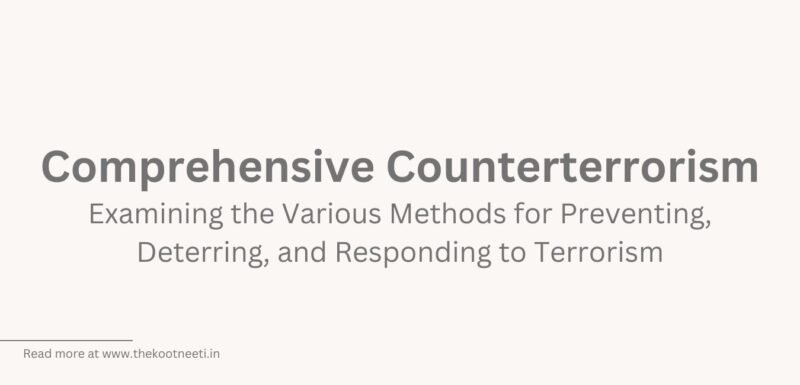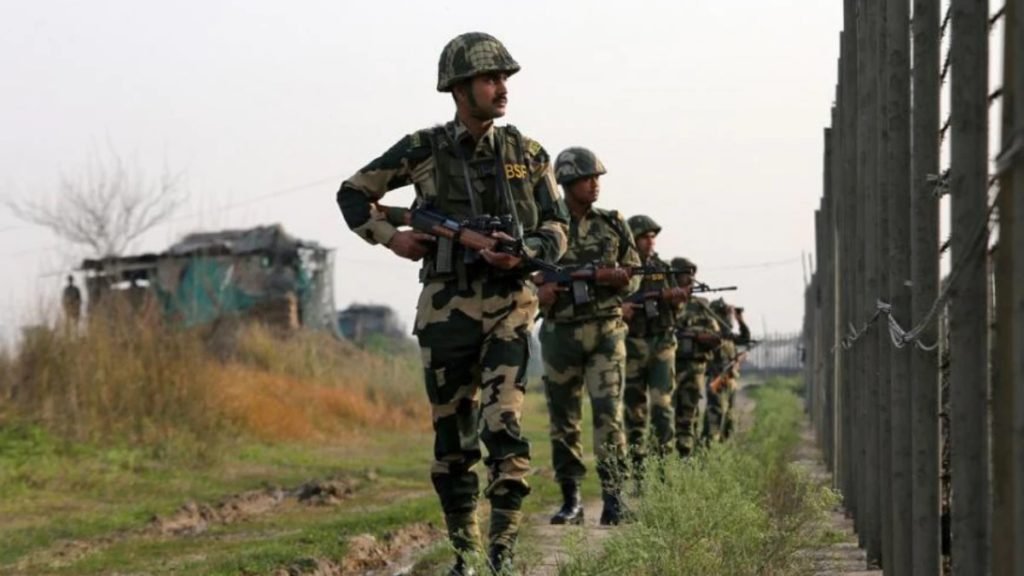Comprehensive Counterterrorism: Examining the Various Methods for Preventing, Deterring, and Responding to Terrorism

Counterterrorism (CT) refers to the practices, tactics, and strategies that governments, organizations and individuals use to prevent, deter and respond to acts of terrorism. CT strategies can be both proactive and reactive, and they can include a range of measures such as intelligence gathering, law enforcement, military action, diplomatic and economic measures, border security, public awareness and engagement, cybersecurity, and resilience and emergency response.
One of the key elements of a successful CT strategy is to disrupt the terrorist organization’s ability to conduct operations and to deny them the resources, support and safe haven they need to continue their activities.
Here we have discussed various methods for preventing, deterring and responding to Terrorism
Intelligence gathering and analysis:
Intelligence gathering and analysis play a crucial role in counterterrorism efforts, as they allow authorities to identify, track, and disrupt potential terrorist threats before they can carry out attacks.
Intelligence gathering in counterterrorism can involve a wide range of activities, including
- Human intelligence (HUMINT)
- Signals intelligence (SIGINT)
- Imagery intelligence (IMINT)
- Open-source intelligence (OSINT)
These activities are designed to collect information about potential terrorist threats, including the identities of individuals or groups involved, their plans, motives, and capabilities, as well as information about their financing, training, and support networks.
Once this information has been collected, it is analyzed to identify trends, patterns, and potential threats. This analysis can involve the use of sophisticated software and algorithms, as well as the expertise of experienced intelligence analysts. The goal of this analysis is to identify the most pressing threats, prioritize them, and inform decision-makers on the best course of action to prevent or disrupt them.

Law enforcement:
Law enforcement plays a critical role in counterterrorism efforts by preventing and responding to acts of terrorism. Law enforcement agencies are responsible for ensuring public safety, protecting critical infrastructure, and investigating and disrupting potential terrorist threats.
To accomplish these goals, law enforcement agencies employ a variety of tactics and strategies, including:
- Prevention: Law enforcement agencies work to prevent terrorist attacks by identifying and disrupting potential threats through intelligence gathering, surveillance, and community outreach. They also work with other government agencies and private sector partners to protect critical infrastructure and to increase public awareness of the threat of terrorism.
- Response: In the event of a terrorist attack, law enforcement agencies are responsible for responding quickly to secure the scene, evacuate the area, and provide medical assistance to those in need. They also play a key role in investigating the attack and collecting evidence that can be used to bring those responsible to justice.
- Enforcement: Law enforcement agencies are responsible for enforcing the law and bringing those who engage in terrorist activities to justice. This can involve arresting individuals who are involved in planning or carrying out terrorist attacks, as well as disrupting financial and support networks that enable terrorism.
Military force:
Military force is sometimes used as part of a larger counterterrorism strategy to disrupt and defeat terrorism. The use of military force in counterterrorism can take many forms, including:
- Direct action: Military forces may be used to conduct direct action against terrorist targets, such as raids, drone strikes, or other forms of targeted operations. This can be an effective way to eliminate high-value targets, disrupt terrorist operations, and disrupt their ability to carry out attacks.
- Support to law enforcement: Military forces may be used to support law enforcement agencies in their counterterrorism efforts, such as providing intelligence, logistics, and other forms of support.
- Counterinsurgency operations: In some cases, military forces may be used to carry out counterinsurgency operations in areas where terrorism is particularly prevalent. This can involve a range of activities, such as providing security, training local security forces, and engaging with local communities to build support for counterterrorism efforts.
- Stabilization operations: In areas where terrorism is a result of larger instability and conflict, military forces may be used to carry out stabilization operations aimed at restoring order and creating the conditions necessary for long-term peace and security.
Diplomatic and economic measures:
Diplomatic and economic measures can play a critical role in counterterrorism efforts by addressing the root causes of terrorism and disrupting its support networks. These measures can include:
- Diplomatic engagement: Diplomatic engagement can be used to build international coalitions and partnerships, share intelligence and information, and cooperate on counterterrorism efforts. Diplomatic engagement can also be used to resolve conflicts and reduce tensions that can contribute to terrorism.
- Sanctions and financial measures: Economic sanctions and financial measures can be used to target individuals, organizations, and countries that support or finance terrorism. This can include freezing assets, imposing travel bans, and cutting off access to financial resources.
- Countering extremist ideology: Diplomatic and economic measures can also be used to counter the ideology that drives terrorism. This can include supporting alternative voices and narratives, promoting education and civil society, and promoting religious and cultural tolerance.
- Humanitarian assistance: Providing humanitarian assistance to communities affected by conflict and terrorism can help to build support for counterterrorism efforts and reduce the appeal of extremist ideologies.
- Development assistance: Development assistance can be used to support economic and social development in areas affected by terrorism, creating the conditions necessary for long-term peace and security.

Border security:
Border security is an important aspect of counterterrorism efforts as it helps to prevent the movement of terrorists and their weapons across national borders. Effective border security can also disrupt the flow of financing and other support to terrorist organizations. Some of the key measures for border security in counterterrorism include:
- Screening and inspection: Implementing effective screening and inspection procedures at borders can help to identify and prevent the movement of terrorists and their weapons across borders. This can include the use of advanced technology, such as biometric identification systems, and the deployment of trained border security personnel.
- Intelligence sharing: Sharing intelligence information between countries can help to identify individuals and groups that pose a threat to border security and to disrupt their movements across borders.
- Interdiction operations: Conducting interdiction operations at borders can disrupt the flow of weapons, explosives, and other materials that could be used to carry out terrorist attacks.
- Strengthening border management: Strengthening border management systems and processes can help to enhance the ability of border security agencies to identify and prevent the movement of terrorists and their weapons across borders.
- Cooperation with other countries: Cooperation with other countries can help to improve the effectiveness of border security efforts, particularly in areas where terrorists may cross multiple borders.
Public awareness and engagement:
Public awareness and engagement play a critical role in counterterrorism efforts by increasing understanding of the threat of terrorism, promoting vigilance and reporting of suspicious activity, and fostering community resilience. Some key aspects of public awareness and engagement in counterterrorism include:
- Community engagement: Engaging with communities can help to build trust and understanding, and can also provide an early warning system for the identification of potential threats. This can include working with local organizations, community leaders, and religious groups.
- Awareness campaigns: Conducting public awareness campaigns can help to educate the public on the threat of terrorism, promote vigilance and reporting of suspicious activity, and foster community resilience.
- Emergency preparedness: Providing training and resources to help individuals and communities prepare for potential terrorist attacks can help to build resilience and reduce the impact of any incidents.
- Encouraging reporting: Encouraging individuals to report suspicious activity can help to disrupt potential terrorist plots and provide valuable intelligence to law enforcement.
- Social media: Utilizing social media and other forms of digital media can help to reach a wider audience and to educate the public on the threat of terrorism, as well as promote vigilance and reporting of suspicious activity.

Cybersecurity:
Cybersecurity plays a critical role in counterterrorism efforts by preventing terrorists from using the internet and other digital technologies to plan and carry out attacks, communicate with each other, and spread propaganda. Some key aspects of cybersecurity in counterterrorism include:
- Protecting critical infrastructure: Protecting critical infrastructure from cyber-attacks is essential to maintaining the stability and security of a country. This can include implementing strong cybersecurity measures in areas such as energy, transportation, and communications systems.
- Disrupting terrorist communications: Disrupting the ability of terrorists to use the internet and other digital technologies to communicate with each other and to plan and carry out attacks is a critical aspect of counterterrorism efforts. This can include using technical tools and legal measures to prevent the use of encrypted communications and to monitor and disrupt online extremist content.
- Sharing information: Sharing information on cyber threats and vulnerabilities between countries, as well as with the private sector, can help to improve the ability of all actors to respond to threats and to prevent attacks.
- Building capacity: Building the capacity of governments, the private sector, and civil society to detect, prevent, and respond to cyber-attacks is essential to maintaining cybersecurity and preventing terrorism.
- International cooperation: International cooperation is critical in addressing cyber threats in the context of counterterrorism, given the global nature of the internet and the ease with which actors can cross borders.
Resilience and emergency response:
Resilience and emergency response are critical components of counterterrorism efforts, as they help to minimize the impact of terrorist attacks and support communities in the aftermath of such incidents. Some key aspects of resilience and emergency response in counterterrorism include:
- Emergency planning and preparedness: Developing comprehensive emergency plans and conducting regular training and exercises can help to ensure that individuals and organizations are prepared to respond to terrorist incidents. This can include plans for responding to various types of attacks, as well as plans for evacuation and communication with the public.
- Building community resilience: Building resilience in communities by providing them with the skills and resources they need to prepare for and respond to terrorist incidents can help to minimize the impact of such incidents. This can include training in emergency preparedness, as well as support for mental health and trauma recovery.
- Coordination of response efforts: Coordinating the efforts of various government agencies, NGOs, and other organizations is essential to an effective response to a terrorist incident. This can include establishing clear lines of communication and establishing a unified command structure.
- Support for victims and families: Providing support for the victims and families of terrorist incidents is critical to their recovery and to building resilience in affected communities. This can include financial assistance, psychological support, and legal aid.
- After-action review: Conducting an after-action review of the response to a terrorist incident can help to identify areas for improvement and to inform future planning and preparedness efforts.


















